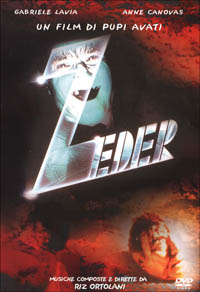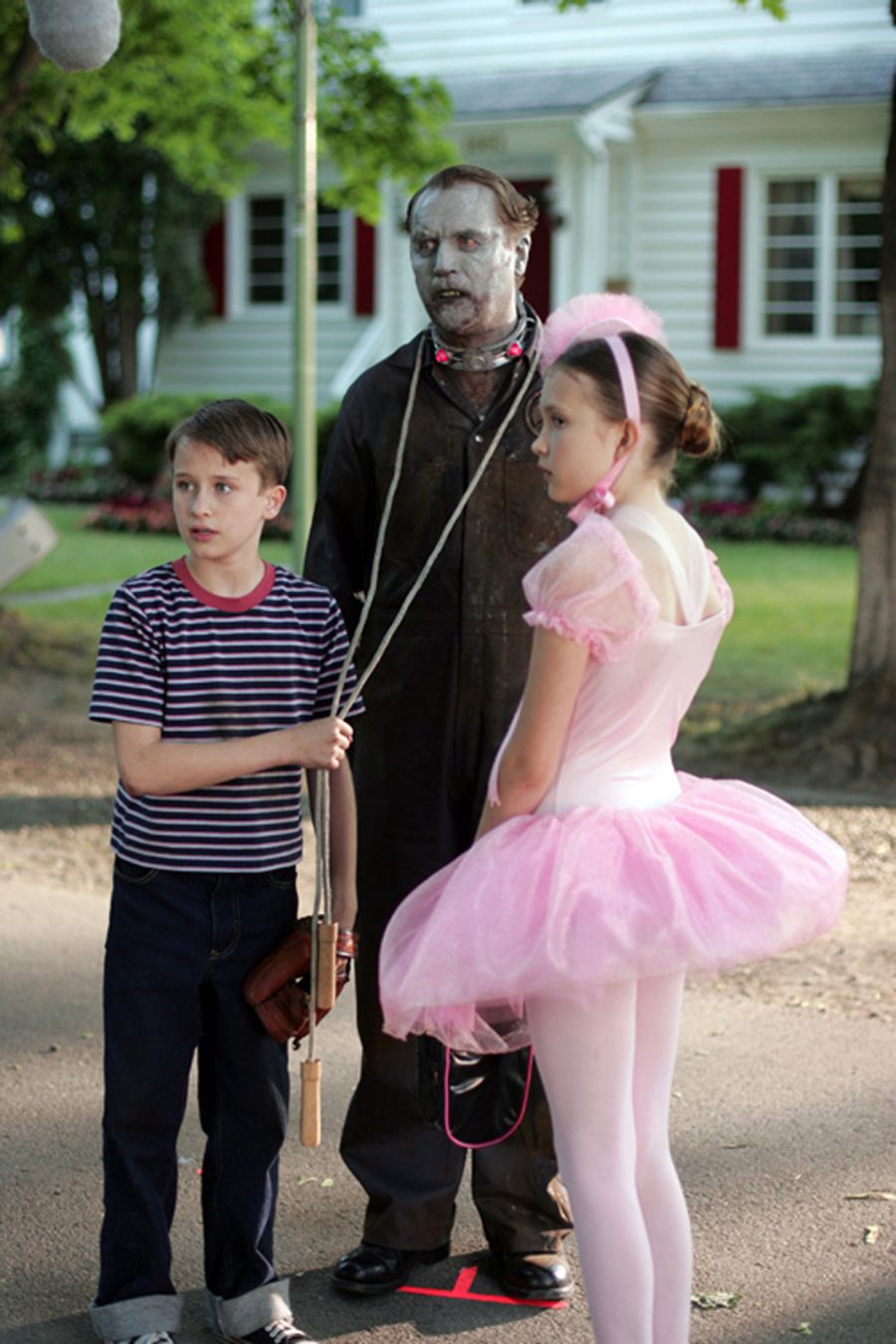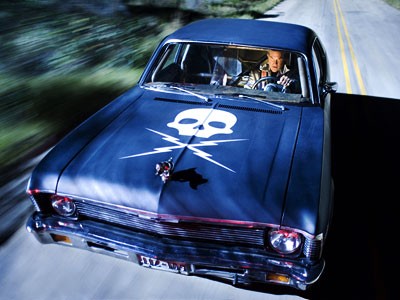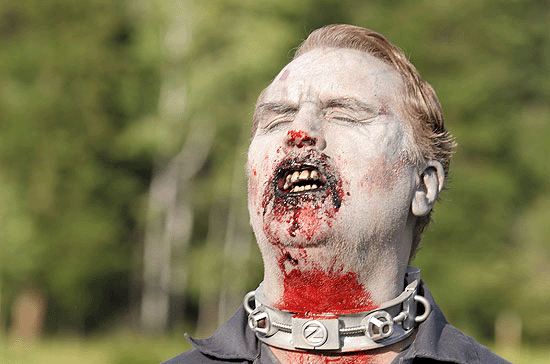 Last night, the American Cinematheque screened ZEDER (1983) as part of its 7th Annual Festival of Fantasy, Horror & Science Fiction Films. The film is not exactly a masterpiece, but it is weird and interesting enough to be worth a mention, for the benefit of horror fans who might not have heard of this obscure title. (The film is also known as VOICE FROM THE BEYOND.)
Last night, the American Cinematheque screened ZEDER (1983) as part of its 7th Annual Festival of Fantasy, Horror & Science Fiction Films. The film is not exactly a masterpiece, but it is weird and interesting enough to be worth a mention, for the benefit of horror fans who might not have heard of this obscure title. (The film is also known as VOICE FROM THE BEYOND.)
ZEDER was directed and co-written by Italian filmmaker Pupi Avati, who in some cult circles is as revered as highly as Mario Bava and Dario Argento, mostly on the basis of this film and on his 1976 effort, THE HOUSE OF LAUGHING WINDOWS. Judging from these two films, one would have to conclude that Avati’s stock in trade was creating a genuinely creepy atmosphere mixed with intriguing metaphysical concepts; he seemed unable to marry these strengths to a coherent narrative, but that did not stop the films from being intriguing and/or disturbing. Continue reading “Zeder: atypical Italian zombie film – Horror Film Review”
Tag: zombies
Fido (2007): A Boy and his Zombie – Horror Film Review

The title may suggest a story about a boy and his dog, and that’s not far off – except that, instead of a dog, the titular character is a zombie. The premise is that, years ago, the Earth passed through a cloud of space dust that turned the dead into flesh-eating zombies. After the “Zombie Wars” put down the undead uprising, a giant corporation called ZomCom managed to domesticate the the walking dead with an electronic collar that quells their urge to eat warm human flesh. Zombies now work in menial tasks, as milkmen, paper boys, and servants; in fact, it somewhat embarrassing for a family not to own at least one zombie.
This set-up sounds like an amusing premise for a mild little low-budget spoof, but FIDO is much more than that: it’s a full-blown social satire with zombies at its center. Equal part LASSIE, old TV sit-coms, and 1950s movie melodramas, the film pokes fun at contemporay society in the tradition of the old TWILIGHT ZONE series – by hiding its commentary in another time, another place. It’s not very scary; it’s not even always hysterically funny. But its satire is always sharp as steel, cutting through the facade of happy, everyday “normality” with almost as sting as David Lynch’s BLUE VELVET.
The story is set in a quiet suburban neighborhood, where the grass is always green and everything is pleasantly upbeat. The Robinson family has recently aquired their first zombie: Dad is phobic about the creatures, but Mom insists that their family not be the only one on the block without one, especially since the head of security at ZomCom has just moved in across the street. Little Timmy, a lonely boy picked on by his peers at school, befriends the family servant and names him Fido. Unfortunately, a malfunction with Fido’s collar results in his attacking and killing a neighbor, setting off a chain reaction of events that results in ZomCom recalling the zombie for use in their factory. But Timmy refuses to give up on his friend and sets out to rescue him…
What makes this relatively simple story shine like a gem is the Technicolor stylings that (despite the modest budget) capture the colorful artificiality of old-time Hollywood movies. The glossy look perfecly captures the complacency blanketing the town, hiding the darker undercurrents. In this regard, FIDO bears some resemblance to Todd Haynes’ charming FAR FROM HEAVEN (2002), which also modeled its look after 1950s Technicolor productions. (In fact, the two films would make an excellent double bill, despite their obvious differences.)FIDO also warrants some comparison to 1998’s over-rated opus PLEASANTVILLE, which also cast its eyes back to the era of 1950s sit-coms.
The crucial difference is that PLEASANTVILLE was supremely smug, patting itself on the back for taking aim at an easy target (the ’50s were, like, so totally un-cool, don’t you know?) and assuming that the only thing wrong with the “Good Old Days” was that they weren’t enough like the enlightened Present. FIDO bears a superficial resemblance, with its young school children indoctrinated with propaganda films and taking target practise to deal with the zombie menace. The word “containment” is ever on the lips – a buzz word literally refering to the need to contain the problem but figuratively signifying the need to conform to the ZomCom authority that keeps everyone safe. In effect, the zombies are like the Red Menace from the Cold War: your neighbors, your friends, your loved ones (especially the old and the infirm) could die at any minute and become one of them – the Enemy Within – so it’s best to keep an eye on those around you and not get too emotionally involved, lest tender feelings make you hesitate to pull the trigger when the time comes.
It is easy to laugh at this portrait of paranoid American culture as some kind of dusty relic of the past, but before long you see the present-day parallels. The zombie menace is a sort of dormant threat, one that must be kept alive because it maintains the status quo. Without it, ZomCom’s ability to run the show would be obsolete and unnecessary. In effect, the unplesant situation is not so unpleasant for ZomCom head of security Mr. Bottoms (Henry Czerny); he actually seems to relish it. It gives life meaning – gives him a reason for existence.
The ugly parallel with today’s political situation is so blatant that it almost needs no explanation. Conservative politicians and pundits embrace the threat of terrorism because it gives meaning to their lives; it seems to justify their world view. We see it in Republican presidential debates, in newspaper editorials, and in the ranting of right-wing bloggers: the subtle (and sometimes not so subtle) wish that the threat continue to thrive because without it their pitiful house of cards will blow apart in the wind.
If FIDO has a failing, it is that, having set this scenario into motion, it shies away from the potentially apocalyptic implications; following the idea to its logical conclusion would result in an explosive destruction of the conventional social order along the lines of George Romero’s DAWN OF THE DEAD. Instead, the film opts for a hokier ending, which at least is in line with its cornball sources of inspiration. Nothing really changes; life goes on, but at least people learn to love their zombies…
Despite this minor failing, FIDO is minor milestone in the history of zombie films. In fact, outside Romero’s LIVING DEAD films, this is one of the few efforts to advance the sub-genre on a conceptual level. The zombie rules are clearly borrowed from the archetype laid out in NIGHT OF THE LIVING DEAD (the school kids even recite a rhyme to remind them to aim for the head, not the heart), but FIDO uses this set-up to go in its own direction by asking a fascinating “What if…?” question: “What if zombies could be domesticated?” Romero himself toyed with this idea in DAY OF THE DEAD, but his characters never got the chance to put it into practise. Now FIDO shows us the results – imaginative, weird, funny, and fascinating.Anyway, Los Angeles fantasy film fans have a two-week window of opportunity to catch this funny, subversive satire. If you miss it in favor of the FANTASTIC FOUR sequel, well…shame on you.
FIDO (2006, released 2007). Directed by Andrew Currie. Written by Robert Chomiak, Andrew Currie; story by Dennis Heaton. Cast: Carrie-Anne Moss, Billy Connolly, Dylan Baker, K’Sun Ray, Tim Blake Nelson, Henry Czerny, Sonja Bennett, Jennifer Clement, Rob LaBelle.
Grindhouse (2007) – Film Review

This homage to exploitation cinema of decades past seeks is not so much a movie as a gimmick that links together two feature films, plus a handful of faux trailers and advertisements – all appropriately scratched and faded to recreate the experience of attending a second-rate “grindhouse” theatre playing beat-up old prints. As amusing as the concept is, the actual result is a considerable disappointment – a high-tech forgery that lacks the disreputable charm of its models, which were made without the self-conscious affectation on display here. The movie is not without its merits, but it’s safe to say that much of it would have been derisively hooted off the screen at any real grindhouse theatre. In at least one sense, however, the film perfectly captures the grindhouse experience: it promises much more than it delivers.
GRINDHOUSE launches with its best foot forward, a fake trailer called “Machete,” starring character actor Danny Trejo as a Mexican man set up by the people who hired him to assassinate a senator. The brief flurry of outrageous violence, overblown dialogue, and hyperbolic narration yields the perfect recipe for an explosive blast of sheer, giddy fun that the rest of GRINDHOUSE cannot possibly match. Perhaps retrofitted exploitation is better in two-minute doses.
That brief opening exhilaration extends through the first few minutes of “Planet Terror,” written and directed by Robert Rodriguez. With a nod to George Romero’s zombie films like DAWN OF THE DEAD and DAY OF THE DEAD (whose make-up supervisor, Tom Savini, shows up in a supporting role), the story portrays a small town in Texas overrun by zombie-like mutants who have been infected by chemical weapons.

After getting off to a good start, the film bogs down in its narrative meanderings. In way, it too closely emulates its models: it’s boring, and you have to wait for the eruptions of gore and violence to break the boredom. By the time the jokey “Reel Missing” title card flashes on screen and the film jumps ahead as if several scenes have been lost, you’re grateful for the quickstep progress in what had hitherto been building tedium rather than tension.
When the shit hits the proverbial fan near the conclusion, the action blast across the screen in an unapologetic way, but the central visual conceit of actress Rose McGowan with a rifle in place of a leg never really comes off, yielding more derisive chuckles than gasps of excitement. (In the low point, she is supposed to blow smoke away from the recently fired weapon, and it is painfully obvious that she cannot get her mouth anywhere near enough to the barrel to have an effect.) At least the episode is partially redeemed by Rodriguez’s simple but effective music, a pounding, repetitive motif that recurs throughout in different permutations, a la Ennio Morricone and John Carpenter.
Next comes a trio of phony trailers: Rob Zombie’s “Werewolf Women of the S.S.,” Edgar Wright’s “Don’t,” and Eli Roth’s “Thanksgiving.” All are amusing, but none match the delights of the opening “Machete.” Wright’s stands out a bit by virtue of aiming at a target other than cheap exploitation films; its visual style consciously recalls higher-class efforts like 1973’s THE LEGEND OF HELL HOUSE (one actor is a dead ringer for Roddy McDowall, right down to his hair cut).
Roth’s trailer perfectly captures the washed-out look and downbeat “serious” tone of sleazeball horror films, and Zombie gets credit for making a mini-movie that includes both Udo Keir and Nicolas Cage (who, despite being an Oscar-winner, has shown a penchant for ham-handed scenary chewing that would be quite appropriate in a grindhouse movie).

Next up is writer-director Quentin Tarantino’s “Death Proof,” which seems deliberately designed to piss off the target audience. One can admire the nerve it took promise “explicit sexuality and hard-core thrills” and then deliver a feature film that consists mostly of two groups of women sitting around in bars, cars, and cafes, talking about their personal lives; however, that does not make the result entertaining. There may be a sly strategy at work here: the character stuff is so boring that you eagerly look forward to the intrusion of death and violence, which takes the form of Kurt Russell as “Stuntman Mike,” who uses his car to plow through the first group of girls but gets more than he bargains for with the second. Unfortunately, Russell is not really the star of the episode – he is off-screen far too long – so his presence is not enough to save it. But he deserves high-fives all around for taking his despicable woman-killer and turning him into a pathetic loser who whines like a baby when the tables are turned on him.
The other big plus in “Death Proof” is the astounding stunt work by Zoe Bell (who doubled for The Bride in KILL BILL). Here, Bell plays herself, on vacation in America, where she goes on a test drive in a white Dodge (like the one from VANISHING POINT) and hangs off the hood suspended by nothing but a pair of belts. Tarantino gets his camera right in on the action so that you can see it is real, with Bell hanging on for dear life when she and her friends run afoul of Stuntman Mike.
Even so, the chase sequence never matches the thrills of BULLET, and Tarantino overplays his hand: several times, the driver of Bell’s care passes up opportunities to slow down and/or stop, so that Bell could get off the hood and back into the car; this stretches the situation out beyond belief or credibility, delaying what we really want to see – and what Tarantino finally delivers – Bell and friends turning the tables and putting Stuntman Mike in his place. Sadly, the comeuppance arrives, satisfying as it is, cannot possibly justify the time it took getting to it.
In the end, GRINDHOUSE is almost exactly the opposite of what it promises to be. Real grindhouse movies were made on fast schedules with few resources; the exploitation elements were necessary in order to give the audience some kind of entertainment value in exchange for their ticket-buying dollar. Running times were short (88 minutes fit into a single canister, making it cheaper to ship to theatres), and self-indulgent filmmaking was pretty much out of the question.
Rodriguez and Tarantino no doubt have sincere affection for these films, but they come across as posers – not too far from Pat Boone covering a Little Richard song. As much fun as the exploitation action is, it lacks the serious sleaze of the genuine article, and it’s not quite arch enough to amuse as camp. And for all the promise of balls-to-the-wall mayhem, what they deliver here is no more hardcore than anything we’ve seen in their previous films. Hopefully, if GRINDHOUSE II is ever made, the Dynamic Duo will take executive producer roles and hand over the directorial reigns to some young, hungry filmmaker eager to churn out a real grindhouse movie. Either that, or Rodriguez could make the actual feature-length version of “Machete.”
PARTING THOUGHT
Put crudely, one might say that watching GRINDHOUSE is a bit like watching two guys jerk each other off while staring at a Playboy centerfold. In their own minds, they’re having sex with a beautiful woman, and for some reason, they expect us to share their fantasy. But only a blindly loyal fan could be blind to the ugly truth.
TRIVIA
The (actual) trailers for GRINDHOUSE feature shots that are not in the final film (such as Kurt Russell saying “I’m not a cowboy; I’m a stuntman.” According to Rose MacGowan, Tarantino wrote a script for “Death Proof” that was long enough to be a stand-alone feature. Expect lots of deleted scenes (or an extended director’s cut) when the film arrives on DVD.
PLANET TERROR DIRECTOR’S CUT
For DVD, the GRINDHOUSE double bill was divided up into two titles, one for Robert Rodriguez’s PLANET TERROR and one for Quentin Tarantino’s DEATH PROOF. Each offerd an extended unrated director’s cut. The longer version of PLANET TERROR still begins with “Machete” – bogus preview for flick about a Mexican day laborer set up to take the fall for a political assassination – which was probably the highlight of GRINDHOUSE when it was in theatres. Unfortunately, the new cut does not alter PLANET TERROR in any major way – it just adds little bits and pieces throughout – so unless you loved the film to begin with, there’s not much reason to see it again. In case, you were wondering, despite restored footage, the “Scene Missing” title card remains in place, so you still will not learn what Wray said to convince the Sheriff to suddenly trust him.
Automaton Transfusion – Horror Film Review

